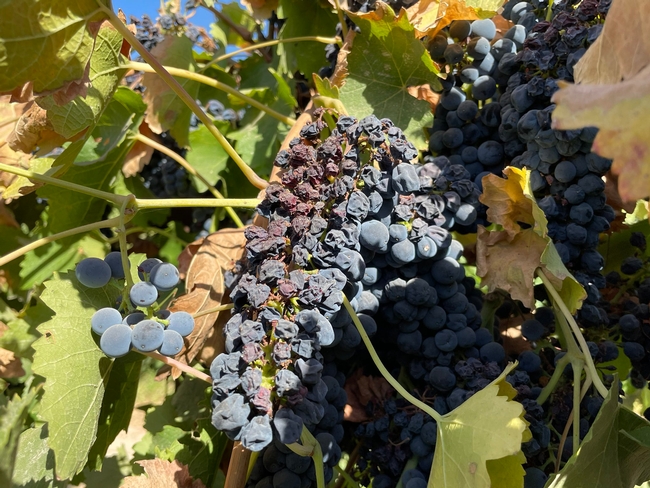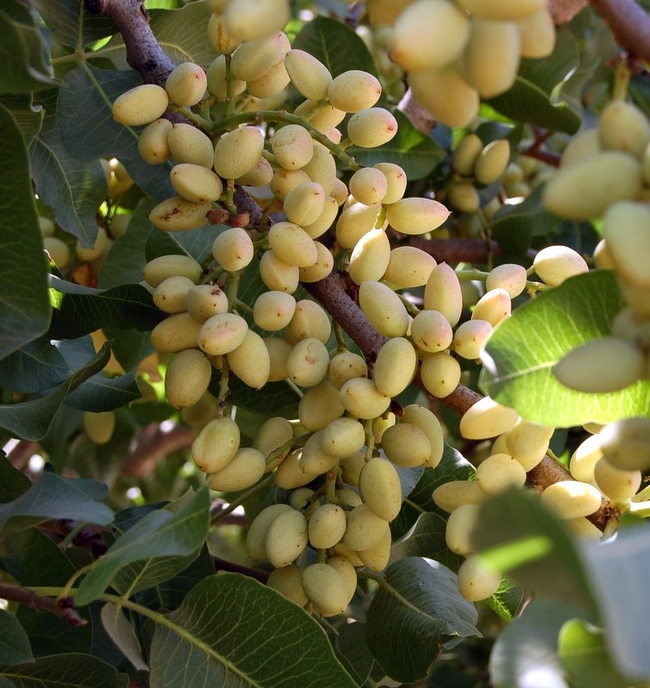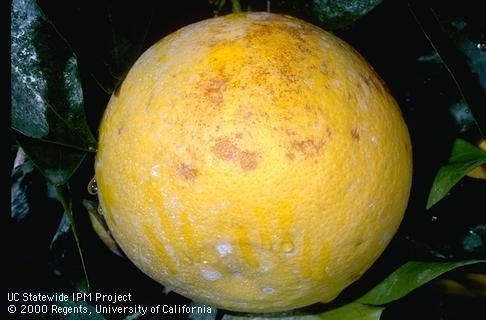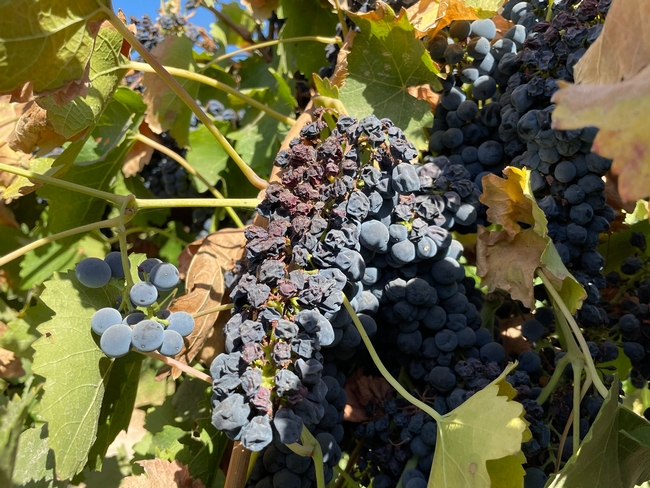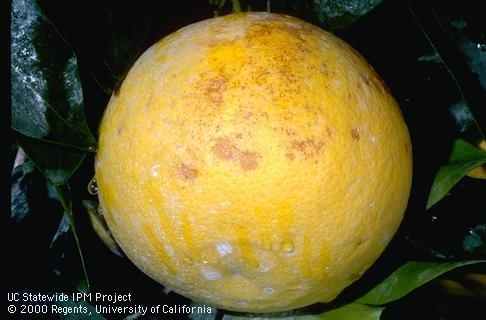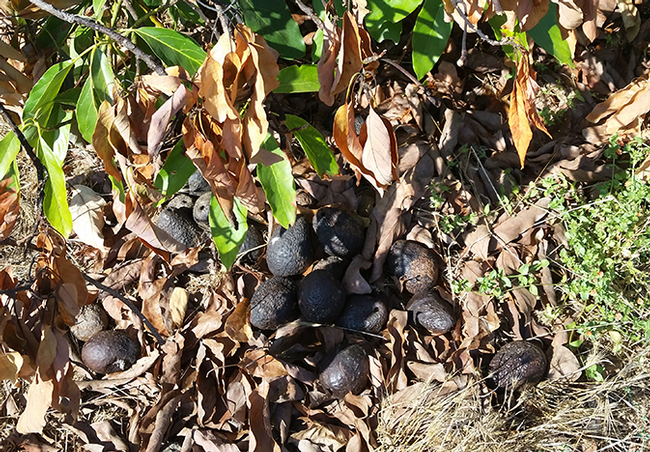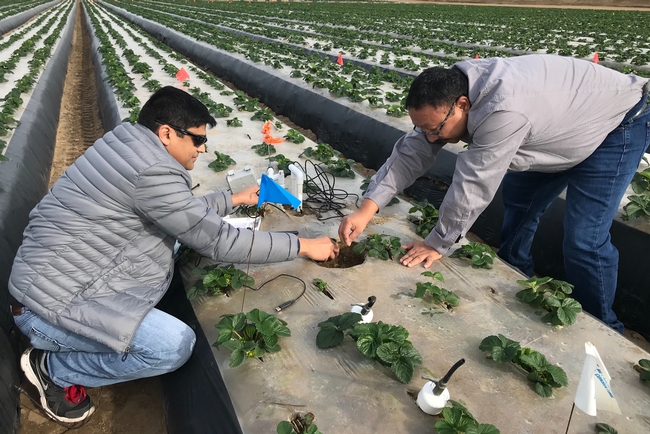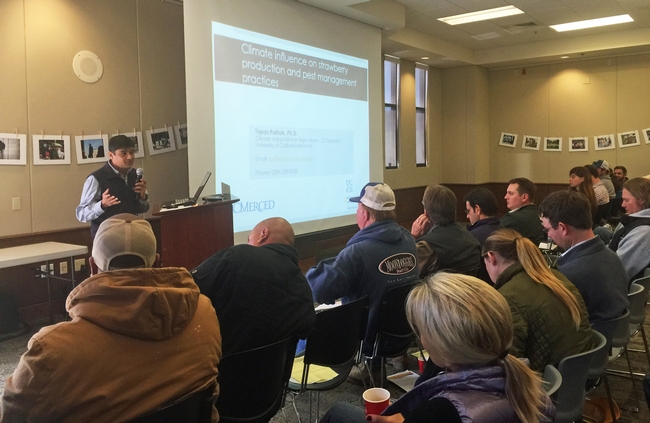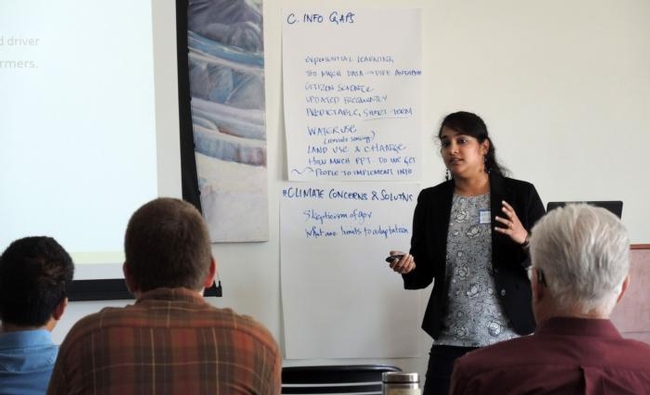Posts Tagged: Tapan Pathak
Key climate data added to enhance grower decision-support tool
Free CalAgroClimate tool helps growers protect crops from frost and extreme heat
California farmers can see how climatic conditions that may affect agriculture are changing in their regions by using CalAgroClimate so they can make strategic changes. Nine new agriculturally important climate indicatorshave been added to the decision-support tool created by UC Cooperative Extension and U.S. Department of Agriculture scientists.
These new tools use a high-resolution climate dataset called PRISM to provide location-specific or county-aggregated long-term trends in agroclimatic indicators from 1980 to last year. These new agroclimate indicators include Frost Days, Last Spring Freeze, First Fall Freeze, Freeze-Free Season, Tropical Nights, Hot Days, Extreme Heat Days, Heatwaves and Diurnal Temperature Range (see definitions below). These indicators were derived from a study published in the journal Agronomy.
All of the new tools are free and available on CalAgroClimate for anyone to access.
“Frost-related tools such as Frost Days, Last Spring Freeze, First Fall Freeze, and Freeze-Free Season can help farmers and agricultural clientele make informed long-term choices,” said Tapan B. Pathak, UC Cooperative Extension specialist in climate adaptation in agriculture based at UC Merced, who is leading the CalAgroClimate project.
“For instance, if you are planning to invest in a frost sensitive crop in your region, these indicators can provide valuable information on whether frost risk has changed over time and whether it is less risky to make such an investment,” he said. “Wine grapes, for instance, are very sensitive to frost. Although not all frost events are damaging, understanding long-term trends in frost can help in making long-term strategic decisions such as whether to invest in frost protections.”
Another set of new agroclimatic indicators, on CalAgroClimate – Tropical Nights, Hot Days, Extreme Heat Days, Heatwaves and Diurnal Temperature Range – are based on higher maximum and minimum temperatures. Tropical Nights, for instance, calculates total number of nights when overnight temperatures exceed 68 F. More frequent tropical nights can increase crop respiration rates and can be detrimental for fruit quality and quantity, increase the risk of damage from pathogens, and potentially impact fruit set and yield.
Knowing how trends are evolving over time can assist growers in managing their crops to reduce risks. Similarly, growers can easily look at trends related to heat – hot days, extreme heat and heatwaves – on CalAgroClimate to assess their options on what they need to do to be adaptive. In the short term, growers may put up shade or for longer term, choose varieties that are more heat-tolerant.
“In recently published work, one of the farmers in the Central Valley told us, ‘When you really see so much difference in a short amount of time in your immediate area…we would have to look at that and say, well, we're going to have to adapt varieties because this is a 20- or 25-year planting and we're going to have to find crops or varieties that will adapt to that,'” Pathak said.
Another farmer told us, “Knowing what's going to happen or at least having a good idea, if you know something's going to be become or won't be viable, then obviously you're going to try to phase that out, and phase in something that's better suited.”
Pathak added, “The new agroclimatic indicators on CalAgroClimate provide a reality check on how conditions are changing in short and long-term, what it means for farmers and to assist them on deciding what they need to do to be adaptive. These tools will greatly benefit farmers and agricultural clientele in assessing risks and making informed decisions.”
Other collaborators include StevenOstoja and Lauren Parker of theUSDA California Climate Hub,PrakashKumarJha of UC Agriculture and Natural Resources and Robert Johnson and ShaneFeirer of UC Agriculture and Natural Resources' Informatics and Geographic Information Systems.
Definitions of AgroClimatic Indicators:
Frost Days are days in a year with minimum temperature below or equal to 32F.
Last Spring Freeze is the latest day in spring when minimum temperature is below or equal to 32F.
First Fall Freeze is the earliest day in fall when minimum temperature falls to 32F or below.
Freeze-Free Season is the time between the last spring and first fall freeze, represented by the number of consecutive days in a year without freezing temperatures.
Tropical Nights are number of nights when temperatures exceed 68F.
Hot Days are the days per year with maximum temperature exceeding 100 °F.
Extreme Heat Days are the number of days per year with maximum temperatures warmer than the 98th percentile of historical summer maximum temperature for the selected location.
Heatwaves are events that occur when extreme heat lasts for at least three consecutive days.
Diurnal Temperature Range is the difference between daily maximum and minimum temperatures.
New interactive web tools help growers cope with climate change
UCCE, USDA California Climate Hub launch CalAgroClimate decision-support tool
Climate and weather variability pose increasing risks to farmers. As world leaders gather in Egypt at COP27 to address the climate crisis, University of California Cooperative Extension and the USDA California Climate Hub are launching new web-based tools to provide farmers with locally relevant and crop-specific information to make production decisions that reduce risk.
“Integrating historical weather data and forecast information with meaningful agricultural decision support information holds the potential to reduce a crop's vulnerability to such risks,” said Tapan Pathak, UC Cooperative Extension climate adaptation specialist at UC Merced.
“To provide easy access to high-resolution data in the form of agroclimate tools and information, and to enhance agricultural resilience to climate and weather-related risks, we are launching CalAgroClimate,” Pathak said.
Pathak is collaborating on building the decision support tool with partners from the U.S. Department of Agriculture, California Climate Hub, UC Cooperative Extension and UC Agriculture and Natural Resources' Informatics and Geographic Information Systems or IGIS.
“CalAgroClimate has been designed to support climate-enabled decision making for those working in the California specialty crop industry,” said Steven Ostoja, Director USDA California Climate Hub. “The USDA California Climate Hub is a proud collaborator on this important initiative to ensure the state's agricultural industry can continue to thrive in a future of climate change.”
Shane Feirer and Robert Johnson of UC ANR IGIS designed the interactive tools on the website and Lauren Parker of the USDA California Climate Hub contributed to content organization.An advisory panel composed of colleagues from UCCE and the Natural Resources Conservation Service ensure CalAgroClimate tools are relevant to stakeholder needs.
“CalAgroClimate is an amazing new tool that puts comprehensive past and forecast weather data at any grower's disposal,” said Mark Battany, UC Cooperative Extension water management and biometeorology advisor for San Luis Obispo and Santa Barbara counties.
“California's high-value crops are subject to a myriad of weather-related risk factors; this tool will allow growers to better address both near-term and long-term risks, and in the end grow more profitably, said Battany, who is a member of the CalAgroClimate advisory panel.
Growers and crop consultants can use CalAgroClimate's crop and location-specific tools and resources to help make on-farm decisions, such as preparing for frost or untimely rain and taking advantage of expected favorable conditions.
CalAgroClimate currently includes heat advisory, frost advisory, crop phenology and pest advisory tools.
Heat advisory tool: Extreme heat poses a danger for people, animals and crops. With this tool, users can select location and temperature threshold (e.g. 90 F, 95 F 100 F) based on their crop-specific heat tolerance level and the tool will provide a customized map of heat risk for next seven days for that location, including the number of consecutive days with temperature above that threshold. Users can also assess overall heat risks across the state for a selected temperature threshold as well. Having an early warning about hot temperatures, growers can take steps to reduce risks associated with extreme heat such as providing shade, changing farm workers' schedules and applying additional irrigation.
Frost advisory tool: Frost risk is a very serious issue for many specialty crops across California. Similar to the heat advisory tool, this tool provides a customized map of frost advisory for next seven days for a user's location, and forecast of consecutive days with temperature falling below the selected temperature thresholds (e.g. 35 F, 32 F, 28 F). Similar to the heat advisory, early warning about cold temperatures can provide growers some time to protect their crops from frost damage.
Crop phenology tool: The scientists have developed a-crop specific and location-specific crop phenology tool to help users keep track of growing degree days accumulations and estimate critical growth stages. CalAgroClimate uses a high-resolution PRISM dataset to provide near real-time crop phenology information to users. This tool will inform growers about how their crop development compares to previous years, which can be helpful in planning activities specific to critical growth stages.
Pest advisory tool: Similar to crops, development of certain pests and diseases is controlled by temperature and heat unit accumulations. With the pest advisory tool, growers can keep track of estimated pest generations during the growing season to make pest management decisions.
“We are launching the website with this initial set of tools while working on adding more crop-specific information and several new tools in the near future, ” Pathak said. “We look forward to getting feedback from growers who use CalAgroClimate to make it even more useful.”
Climate-change research provides tools for farmers to adapt
This is one of a series of stories featuring a sampling of UC ANR academics whose work exemplifies the public value UC ANR brings to California.
Farmers are already seeing the effects of warmer winter nights and hotter summer days on their crops. Climate change is gradual, but increasing overall temperatures affect many aspects of farming, including where and how crops are grown. Tapan Pathak, University of California Cooperative Extension specialist based at UC Merced, is doing applied research that farmers and ranchers can use to adapt to new conditions created by a variable and changing climate.
“You don't have to shift your practice tomorrow, but if you are thinking of making a 30-year investment, it's important to know what risks there are for planting different crops,” said Pathak, who is based in the Sierra Nevada Research Institute at UC Merced.
Pathak co-chairs the UC Cooperative Extension Climate Change Program Team, whose mission is to increase the capacity among UCCE academics to address climate change concerns with science-based information. Pathak also collaborates with extension professionals from across the western U.S. to do extension events related to climate change adaptation. He works closely with state and federal agencies statewide and growers to identify changes occurring as a result of climate change that affect agriculture. Pathak's research will inform growers' decisions, such as crop variety, planting and harvest dates, extreme heat and frost protection and pest management.
“We are seeing impacts of climate change, that's evident. We have some solutions that are available, but we also need to do more locally relevant crop specific research to make agriculture resilient to climate risks,” Pathak said.
The UCCE scientist was the lead author on an important paper that synthesized the impacts of climate change on California agriculture and offers directions for future research and implementation. The authors concluded that almost all of California's crops, collectively valued at more than $50 billion a year, will be endangered to some degree by rising temperatures and variable weather patterns. The study “Climate Change Trends and Impacts on California Agriculture” was published in Agronomy in 2018.
“I think there's a lot of solutions available and there is also a clear need for adaptation research that include growers' perspectives,” said Pathak, who received a Climate Leadership Award for research from the California Climate & Agriculture Network.
Pathak is also collaborating very closely with UC Davis-based UCCE specialist Daniele Zaccaria, who is leading an international project on evaluating bioclimatic indices and developing the index that is more relevant to irrigated agriculture, which includes scientists from the U.S., Italy, Brazil and Chile.
“A bioclimatic index specific to irrigated agriculture can provide more accurate and valuable agricultural drought information that could be helpful for water resources planning and management decisions,” Pathak said.
Cal AgroClimate
Pathak is developing a web-based decision support system called Cal AgroClimate to help growers make decisions, in partnership with the USDA California Climate Hub director Steven Ostoja. It is being built on the same platform as AgroClimate, which is popular with growers in the Southeast.
Cal AgroClimate translates historical climate data and future projections into a useful decision support system for growers. For example, growers can get extreme heat and frost advisories for the next 10 to 14 days in their region and relevant resources to mitigate risks for their selected crop. It is in the early phase of development and will include a suite of tools based on the needs and priorities identified by UCCE colleagues, growers and the agricultural community in general.
In addition to his work on Cal AgroClimate, Pathak has been conducting research on specific crops.
Tomatoes
In a study looking at processing tomato production in the Central Valley, Pathak and UCCE advisor Scott Stoddard found that changing temperatures will likely change the tomato growing season. The scientists looked at processing tomato data starting from 1950 and projections for 2030-2040 to see how the time to maturity is changing.
“In general, the time from emergence to maturity, the timeframe for processing tomatoes in that region is going to shrink by two to three weeks,” said Pathak. “A lot of processors have their timeline for when they need the tomatoes for processing and so when you have this shift in the phenology, that alters the timeframe for when they mature and are ready for the processors. So, there's a whole shift in the management that growers might have to think about in the future.”
Almonds
To identify the climate information almond growers need to take adaptation action, UC Berkeley postdoctoral researcher Kripa Jagannathan, former UCCE advisor David Doll and Pathak interviewed almond growers in the Central Valley. During their conversations with farmers, the researchers clarified that long-term climate projections are not seasonal forecasts or weather forecasts for the next 20 to 30 years. The projections provide information on trends or potential of shifts from historical conditions for making long-term planning decisions.
Pest control is one area where growers will need to make changes. Research by UCCE advisor Jhalendra Rijal and Pathak shows the almond pest navel orangeworm is already extending its life to a fifth generation during a season.
Strawberries
For strawberries, Pathak, UCCE entomology and biologicals advisor Surendra Dara and postdoctoral researcher Mahesh Maskey have developed a model to forecast weekly crop yields based on weather data. “The model was pretty accurate for the Santa Maria region,” Pathak said. “A crop-specific model can be used for labor management not just crop management.”
Because California produces more than 400 agricultural products, adapting to climate change will be more complex than in other states.



